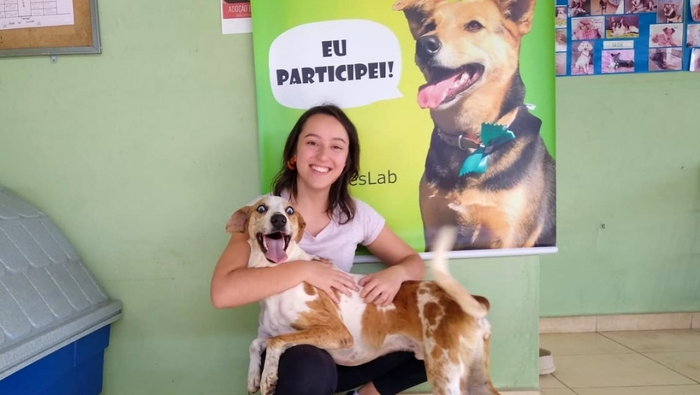It’s an everyday scene. Pooch wants a tasty-looking piece of cake that’s sitting on the table. What does he do? He gazes longingly at the titbit, ogles his master or mistress, and glances back at the cake. This “conversation” with humans gets him what he wants.

Credit: USP
It’s an everyday scene. Pooch wants a tasty-looking piece of cake that’s sitting on the table. What does he do? He gazes longingly at the titbit, ogles his master or mistress, and glances back at the cake. This “conversation” with humans gets him what he wants.
Communication between dogs and humans involving an exchange of looks is very common, but different life experiences can change it, according to a study conducted at the University of São Paulo (USP) in Brazil.
The study was supported by FAPESP via a project to develop an ethological approach to social communication between various species – humans included.
An article on the study is published in the journal Behavioural Processes, discussing the use of gaze alternation by dogs. Gaze alternation can be defined as staring at a human to get their attention, flicking the eyes to where an unattainable object is located, then gazing back at the human, all with little or no head movement.
The researchers compared 60 pet dogs of various breeds and ages. They found that 95.7% of those living inside the home used gaze alternation at least once, while those living outside communicated less intensely (80%). Dogs living in shelters had less contact with humans and interacted less (58.8%).
“The findings point to strong influence of life experience on development and use of communicative behavior. Dogs that spent longer near people were more disposed to use communication as a strategy to obtain a desired objective,” said Juliana Wallner Werneck Mendes, who conducted the experiment at the Canine Laboratory in USP’s Department of Psychology during her master’s research.
This is the first study on the difference between dogs that live alongside humans inside the home and those that live outside and interact less intensely with their owners.
“Another important aspect we observed was that all groups communicated,” Mendes noted. “Shelter dogs used to be considered unable to communicate with humans. In fact, they do, but less so. This shows that the experiences of a lifetime result in different kinds of behavior.”
According to Mendes, low interaction by shelter dogs should not be interpreted as incapacity. “On the contrary, they’re capable of communicating, even with little exposure to humans,” she said. “Previous studies have shown that they learn to exchange looks very quickly when interacting with humans.”
This capacity derives from the animal’s ability to learn. “Shelter dogs are very well-adapted to the situation. They don’t need to communicate with humans for much of their lives,” said Briseida de Resende, a professor at USP and Mendes’s joint thesis advisor with Carine Savalli Redigolo.
Resende explained that the findings from the study refute an old dichotomy between nature and nurture in the field of ethology, the science of animal behavior. “Canine behavior is largely inherited, of course, and they were domesticated a very long time ago, but this aspect should never be abstracted from the context in which they live. Nurture and the environment are also very important,” she said. “The micro context [life experience] is as influential as the macro [evolution of the species]. The nature versus nurture debate has been going on for a long time, and we’re always looking to see how much canine behavior is innate and how much is learned, but currently we’re moving toward the view that it makes no sense to separate the two.”
###
About São Paulo Research Foundation (FAPESP)
The São Paulo Research Foundation (FAPESP) is a public institution with the mission of supporting scientific research in all fields of knowledge by awarding scholarships, fellowships and grants to investigators linked with higher education and research institutions in the State of São Paulo, Brazil. FAPESP is aware that the very best research can only be done by working with the best researchers internationally. Therefore, it has established partnerships with funding agencies, higher education, private companies, and research organizations in other countries known for the quality of their research and has been encouraging scientists funded by its grants to further develop their international collaboration. You can learn more about FAPESP at http://www.fapesp.br/en and visit FAPESP news agency at http://www.agencia.fapesp.br/en to keep updated with the latest scientific breakthroughs FAPESP helps achieve through its many programs, awards and research centers. You may also subscribe to FAPESP news agency at http://agencia.fapesp.br/subscribe.
Journal
Behavioural Processes
DOI
10.1016/j.beproc.2021.104487
Subject of Research
Animals
Article Title
Effect of different experiences with humans in dogs’ visual communication
Article Publication Date
24-Aug-2021



